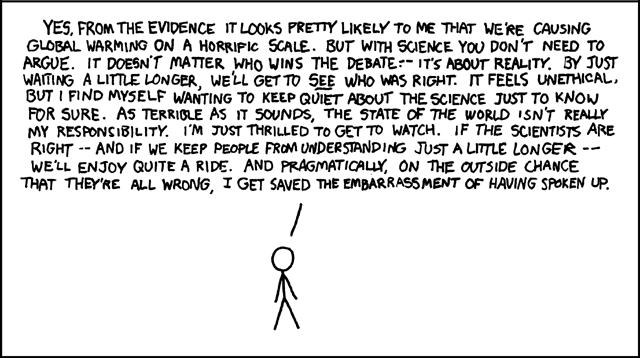First, Global warming denialists denied the existence of GW outright.
As the case for GW became ever more obvious, the energy industry hired scientists to debunk it. The scientists went off checked the research/data ect and came back saying "We can't debunk it because it's real". The oil industry accepted GW as genuine, but the coal industry was determined to fight on.
The coal industry, namely Peabody Coal hired PR spin doctors to discredit the science, and it was those spin doctors who coined the phrase Climate Change, because it sounded less threatening than Global Warming.
Then the coal industry hired psuedo-scientists with no credibility to lose to cloud public perception with bogus scenarios as responsible for GW/CC.
So since then we've had crackpot theories like 'the sun did it', 'Milankovic cycles are responsible' and a plethora of other psuedo-scientific fairytales every year or so which are debunked and then recycled again despite prior debunking.
Anyway, no matter how many moonbat theories or continued denying of GW and its causes both present and in Earth history, the phenomena continues unabated.
Now, as ice on land decreases and moves into the oceans as an ever increasing pace, we have a rapid expansion of sea ice.
So the question to ask now is, when the sea ice melts and combines with more land based ice thaws, how far and how rapid will the oceans rise?
Wouldn't it be funny if Al Gore's Inconvenient Truth was more conservative than reality and the GW denialists' couldn't get insurance?
Antarctic bases battle record ice
http://theaustralian.newspaperdirect.co ... iewer.aspx
Record Antarctic sea ice is forcing scientists to consider relocating research bases as they struggle to cope.
Satellite observations show a new daily record being set for Antarctic sea ice every day for the past two weeks. Annual records have also been broken every year for the past three years.
Rob Wooding, general manager of the Australian Antarctic Division’s Operations Branch, said expanding sea ice was now causing serious problems.
Last year, fuel supplies were flown to Australia’s Mawson base by helicopter because the harbour had failed to clear. Dr Wooding said the situation was “unsustainable”.
He said it was possible for the Aurora Australis icebreaker to break through a certain amount of sea ice to enter the harbour, and the planned capability of a replacement icebreaker would increase the ability to do this. But conditions experienced last year of thick sea ice, with snow cover, extending out 40km to 50km could not regularly be navigated by any Antarctic resupply vessel.
“If we were to face such a situation at Mawson for three or four successive seasons, it would be unlikely that we could continue to resupply the station under the current operating model,” he said. “Unless we could find an alternative resupply strategy, questions would arise as to the ongoing viability of the station.”
French scientists have already been forced to resupply their bases over ice and a number of radical solutions are being considered, including bigger icebreakers, air drops and hovercraft.
The world’s leading Antarctic supply teams and scientists are meeting in Hobart this week to discuss plans in light of the strong trend in growing Antarctic sea ice extent.
Dr Wooding said the growing sea ice presented many logistical problems.
Seasonal growth in Antarctic sea ice is now under way and is expected to peak at another record level in September. Scientists say the increases in sea ice mask much larger regional changes in sea ice distribution, as well as changes in the physical properties of the ice itself. Professor Tony Worby, chief executive of the Climate and Ecosystems Co-operative Research Centre, said expanding Antarctic sea ice had not been expected initially with climate change, but was now better understood.
While the overall Antarctic ice mass was reducing, sea ice was expanding due largely to changed wind patterns driven by ozone depletion, greenhouse gas accumulation in the atmosphere and natural variability. Recent research had also shown the ice is thicker than previously thought.
“Sea ice is one of the most difficult to get right in numerical models,” Professor Worby said.
He said sea ice expansion had been in “very significant contrast to ice extent in the Arctic”.
One reason for the difference, he said, was Arctic sea ice was land locked but Antarctic sea ice was surrounded by ocean and free to expand as wind patterns changed.
If Donald Trump is so close to the Ruskis, why couldn't he get Vladimir Putin to put novichok in Xi Jjinping's lipstick?
